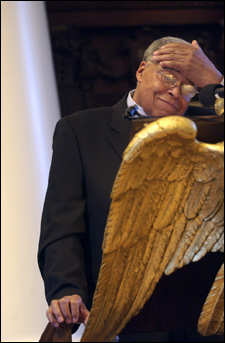Jones delivers Humanitarian Lecture
Actor James Earl Jones receives Harvard Foundation Award
James Earl Jones was a student at the University of Michigan when he first

encountered racial prejudice aimed at him personally. A professor pointed out a misspelling in a paper Jones had written and said: “Why are you trying to be something you’re not? You’re just a dumb son of a bitch, and you don’t belong at this university.”
The experience, Jones said, “left me speechless and baffled.” It wasn’t so much that the professor thought that he was stupid or that he didn’t belong at the University of Michigan. During moments of insecurity, Jones had wondered about these things himself. It was rather the professor’s assumption that Jones was aspiring to a goal he could not possibly reach – for what could he possibly know of his student’s talents or potential beyond what he had gleaned, or thought he had, from a superficial reading of his appearance?
The ignorance and cruelty inherent in qualitative judgments made on the basis of appearance alone was the theme of Jones’ talk at the Memorial Church on Wednesday (April 28). The distinguished stage and screen actor, whose roles have included Othello, King Lear, Jack Johnson, Malcolm X, Paul Robeson, and the voices of Darth Vadar in “Star Wars” and Mufasa in “The Lion King,” was at Harvard to deliver the annual Peter J. Gomes Humanitarian Lecture and to receive the 2004 Harvard Foundation Humanitarian Award. His talk was titled “The Color of Delusion.”
Jones began by holding up a book, “The Family of Man,” a collection of photographs edited by Edward Steichen and first published by the Museum of Modern Art in 1955.
“I believe this is one of the most important books of all time. It doesn’t separate people into different races or cultures. It simply shows all peoples engaged in living. It is the image of the family of man I hold in my heart, and it forces me to ask what has happened to the family of man?”

Even after such catastrophic and chastening events as the Civil War, the Holocaust, and the Civil Rights era, society always seems to be in danger of reverting to racism, Jones said.
“These old ideas overwhelm common sense. A lot of people are afraid of new ideas. It’s the old ones that frighten me.”
One of the old ideas that Jones finds most disturbing is the notion that people of one race are inherently superior to those of another. Even the concept of race itself breaks down in the face of recent scientific evidence. Modern DNA studies have utterly discredited old notions of racial purity, showing that people around the world have 99 percent of their genes in common. Such studies also confirm the fact that all the people of the world can be traced back genetically to a single African woman.
“When some people are described as African American, this only means their ancestors left Africa more recently. That’s all there is to quibble about. We are all African American … or African Hungarian or African Swedish or African Irish.”
Jones warned against resentment as a response to racial prejudice because of its crippling psychological effect. His own grandmother, of African and Native American descent, exemplified such a response.
“She was quite mad,” Jones said. “During World War II she sided with General Tojo of Japan because, she said, ‘he’s a colored man, too.’ When it was pointed out to her that the Japanese were allies of Adolf Hitler, she said she had no quarrel with Hitler if he wanted to invade Mississippi.”
But there is evidence that even Hitler, the patron saint of extreme racists,

showed a supreme cynicism in promulgating his noxious doctrines. Jones read a passage from Hitler’s writings in which the dictator admits that the idea of Aryan superiority has no real scientific basis, but that he finds it useful in achieving his political aims.
“This declaration by the most lethal racist in human history shows that race is no more than a social construct,” Jones said.
Nor does physical appearance have anything to do with the mental or moral behavior of individuals.
“Not all people with big noses are greedy, not all dark-skinned people are good dancers, and not all blondes are dumb. My wife of 22 years is blonde, and I would be one dumb African American if I thought that.” (Jones is married to actress Cecilia Hart.)
Judging people by their appearance is different from assessing new acquaintances on the basis of mannerisms, clothing, or hairstyles, Jones pointed out.
“These are chosen styles, and the choices people make tell us about their character. They are also opportunities for deception. We know that patriotic uniforms and pious vestments do not necessarily reflect people’s inner convictions.”
Despite the lack of correlation between outer appearance and inner worth, various pseudosciences have attempted to draw such parallels, notably the theory of physiognomy, which flourished during the era of colonial empires, and eugenics, whose greatest popularity corresponded with the rise of fascism.
“These short-lived hoaxes found fertile ground in societies bent on world domination,” Jones said.
What then is the origin of these irrational and pernicious beliefs that exhibit such perplexing tenacity? Jones located racism’s power in the fear of the “Other,” “the imagined antithesis of our own kind, whose characteristics do not merit the trust we give to members of our own group.”
In mythology, the Other is often seen as a monster, the fearsome Grendel as opposed to the hero Beowulf. During the Age of Exploration, when Europeans encountered people of different cultures, religions, and skin colors, these unfamiliar others came to embody many of the qualities that had informed European mythologies.
Africans assumed the lowest place in the fictitious human hierarchy because the Africans whom Europeans encountered had in most cases already suffered the degradations of slavery. The slaves who were brought to America in the early 17th century appeared helpless, physically debilitated, and unable to communicate, even with each other because the boatloads of prisoners had been assembled from different tribal groups. Even Native Americans, whom the Europeans dismissed as mere savages, seemed superior to these wretched captives.
Racism has also been kept alive by financial considerations, Jones said. “Racism exists because someone profits. This was obvious in slavery times, but more subtle today.” He mentioned the practices of redlining and gerrymandering as ways in which people of color are barred from enjoying their share of economic benefits.
Returning to the theme of the family of man, Jones said he counted on the human ability to use language as the way out of the trap of racism.
“The ability to accumulate and share knowledge makes us members of the human family. Thanks to the gift of language, human beings can transcend their limitations and become spiritual beings.”




